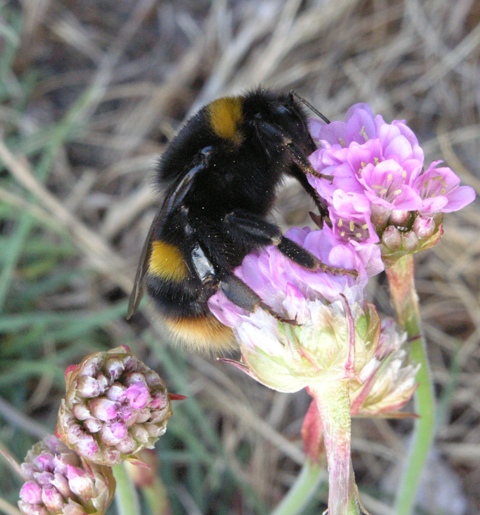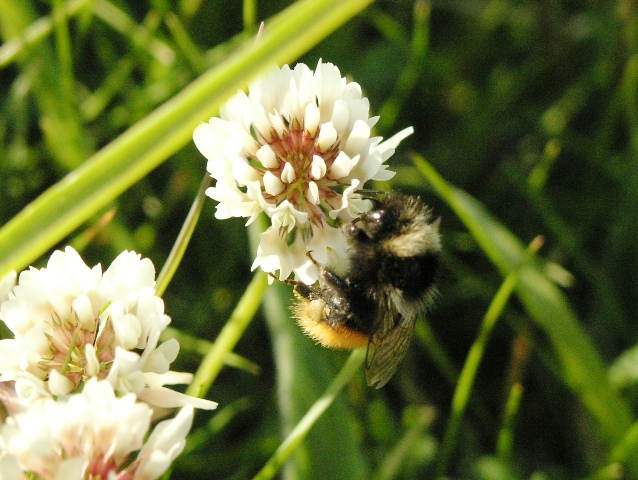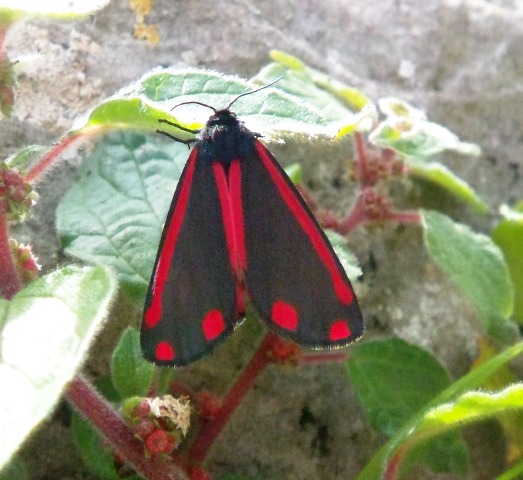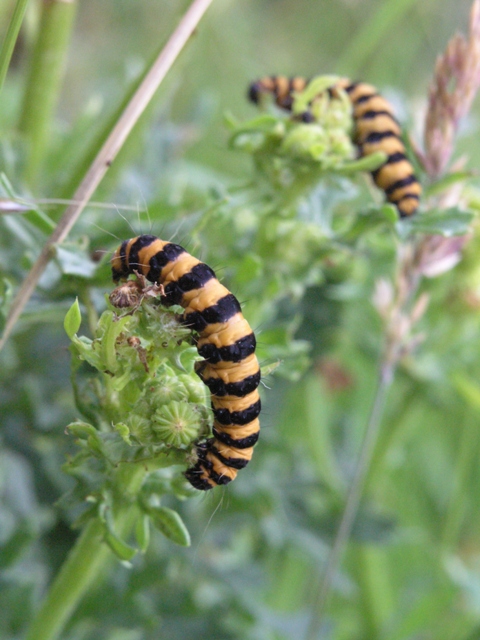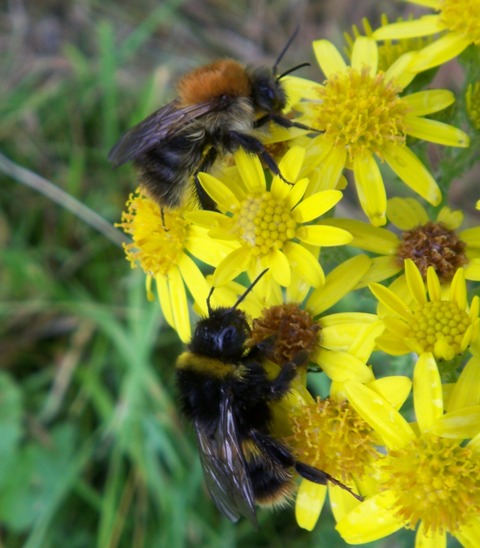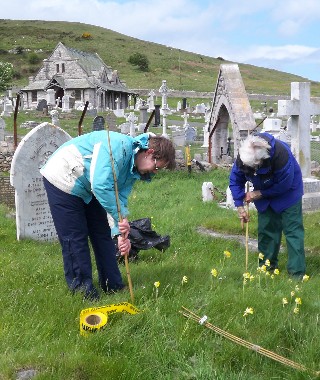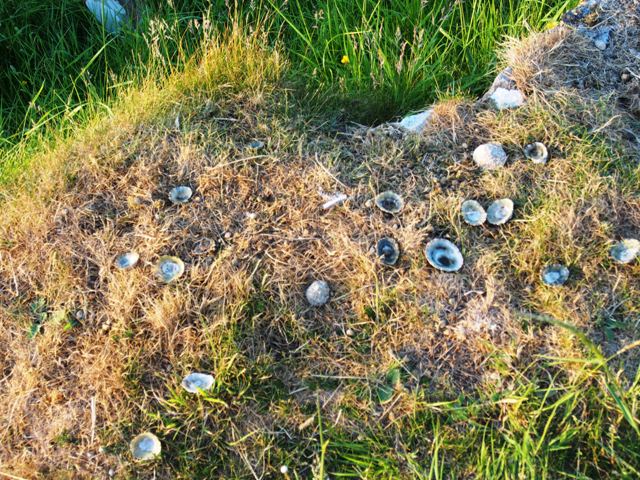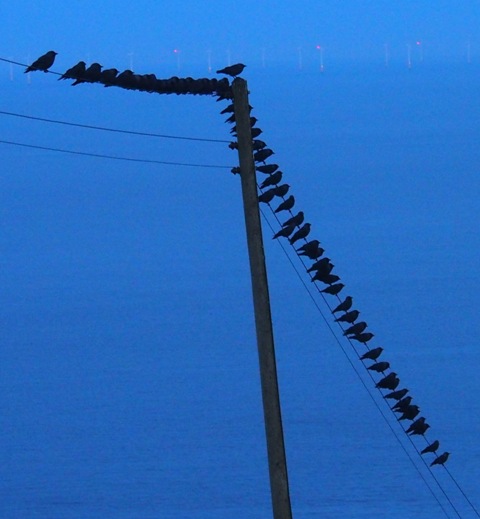We try to maintain the churchyard to allow wildflowers and wildlife to
flourish, while preventing the graves from becoming overgrown.
Although it is not always easy to achieve both objectives, we are
encouraged by the amount of wildlife appearing in the churchyard.
We were delighted to have had a nest of bumblebees in the churchyard
during summer 2012.
The entrance to the nest was a hole in
the ground between the flat slab and the cross shown in this
photo. Anyone standing quietly on the path was able to see
and hear the bees buzzing in and out of the nest. Bumblebees are
placid and rarely sting but they might sting if the nest is
disturbed. By staying on the path, watchers and the bees were all
safe.
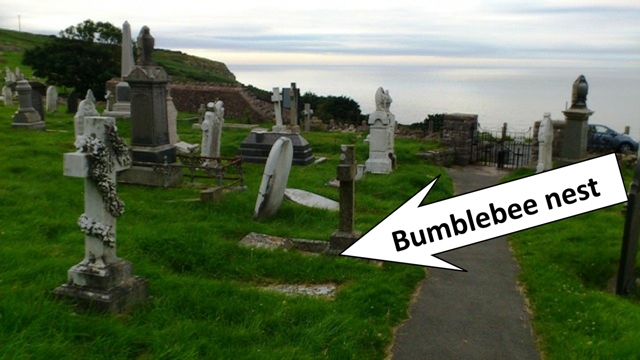
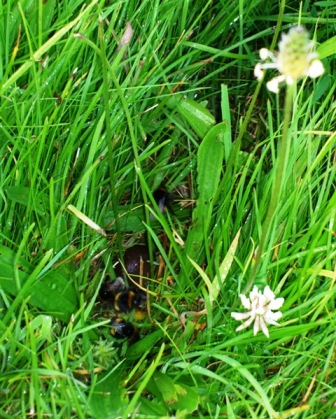
These were buff
tailed bumblebees (Bombus terrestris),
like the one shown in this photograph below. Buff
tailed bumblebees nest in holes below ground (e.g. mouse holes). Brightly
coloured balls of pollen may have been seen on the legs of
bees returning to the nest. The pollen feeds the developing
larvae.
Nearly all of the
bees going in and out of the nest would have been female worker
bees. The
queen is very much bigger than the workers. The males appear in
late summer and do not gather pollen or return to the nest once they
have left it, though other males may hang around waiting to meet the
new
queens. At night and if it is raining, the female bees stay in
the nest but the males have to find other shelter, often under flowers
which they use like umbrellas.
As summer turns to autumn, the old queen, workers and males will all
die and the new queens will each search for another hole in the ground
in which to hibernate. The queens emerge again in spring and each
will look for a suitable place in which to make a nest and form a new
colony.
The buff tailed bumblebee is one of the more common bumblebees in the
UK. However, the numbers of all bumblebees have been declining as
the number of wildflower meadows has declined and we are privileged to
have a nest here in the churchyard. Bumblebees are very important
pollinators of wildflowers, fruit, vegetables and crops. It is
important that we do all we can to help bumblebees survive.
Wildflowers and cottage garden plants generally provide more
nectar and pollen for bees than do modern bedding plants.
You can learn more about bumblebees from the Bumblebee Conservation Trust.
top of page
Bilberry bumblebee
In September 2011 this bilberry bumblebee (Bombus monticola) was spotted
foraging on white clover in the churchyard. A ball of pollen can
be seen on the bee's hind leg. It would be more usual to find
this bee in the mountains and as far as we are aware this was the first
record of this bee on the Great Orme. Another bilberry bumblebee
was seen on the opposite side of the Great Orme in October 2012.
top of page
Cinnabar moths (Tyria jacobaeae)
are occasionally seen in the churchyard we usually see the brightly
coloured caterpillars feeding on ragwort during
August. However, if sheep get into the
churchyard they will eat most of the ragwort flowers which we had hope
will
feed wildlife.
top of page
Common ragwort (Senecio jacobaea)
is the main food plant of cinnabar moth caterpillars and is also an
important source of nectar for bumblebees and other insects during late
summer. In this photograph of ragwort in the churchyard the top
bee is a common carder bumblebee (Bombus
pascuorum) and the bottom one is a buff tailed bumblebee (Bombus terrestris). Common
ragwort in hay can be dangerous to horses but in the churchyard it
poses no danger to livestock and the plants are left to grow when the
grass is cut, to provide food for insects. This policy is
approved by the Great
Orme Country Park. Further informationon ragwort can be found
on the UK
Wildflowers website.
top of page
Pyramidal orchid
In 2009 two pyramidal orchids (Anacamptis
pyramidalis) were found in the churchyard and have reappeared
each year. Unfortunately, sheep grazing on the Great Orme
sometimes get into the churchyard (particularly if a gate is left open)
and eat the flowers before they have a chance to set seed. The
Great Orme goats do not do this.
In 2013 it was found that the orchids had increased in number and
spread, so an area of grass to the east of the church was left
uncut. It is hoped that with appropriate management the orchids
will continue to thrive.
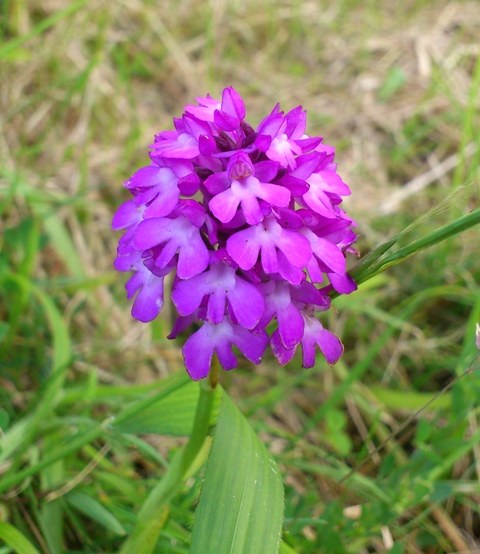
Other wildflowers
In spring, primroses, cowslips
and bluebells can be found in the churchyard. As the seed heads
can be difficult to spot when the grass is cut, the Friends
of St. Tudno's Church mark patches of flowers with canes and tape,
to show the grass cutters which areas to leave uncut. (N.B.
The building in the background of this photograph is the cemetery
chapel
and not St. Tudno's Church.) In late summer the grass cutters
leave other plants such as thistles and knapweeds to flower, to provide
late season food for bees and other insects.
In the summer of 2013 it was observed that collections of limpet shells
were appearing on graves or other flat areas and this photograph shows
one of the larges collections, which also included same fish bones and
a crab shell. We assume that these have been brought here by
birds and oystercatchers have been suggested, though we are unsure
whether they venture this high on the Great Orme. We would
welcome any other suggestions.
In the evenings, jackdaws (Corvus
monedula) often congregate in the churchyard and may be seen
perching on many of the headstones or on the telegraph wires just
outside the churchyard.
Other bird visitors to the churchyard have included a firecrest (Regulus ignicapillus) or two.
We would be very pleased to hear from anyone with records of birds or
other wildlife spotted in the churchyard. Please contact St.
Tudno's.
top of page





